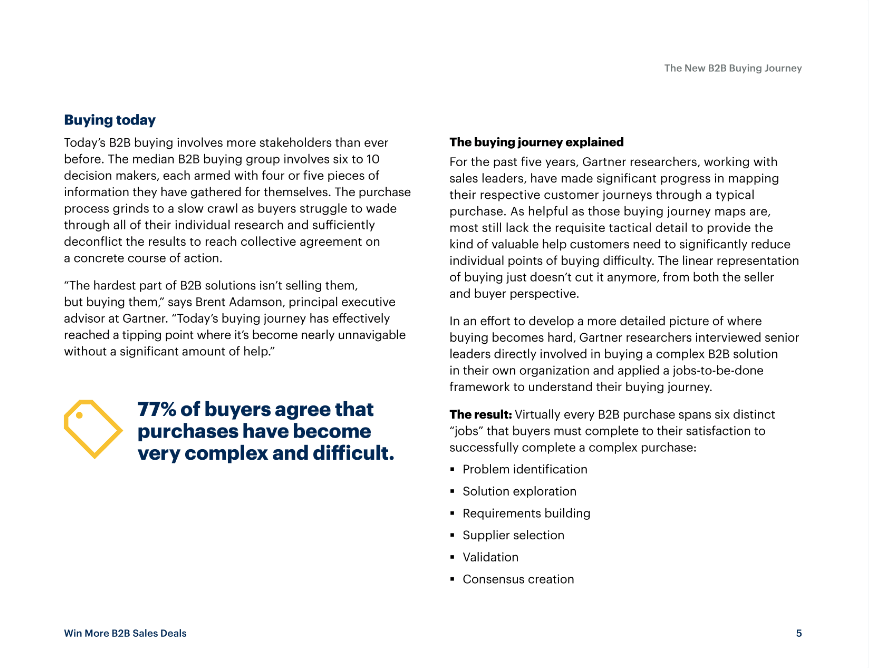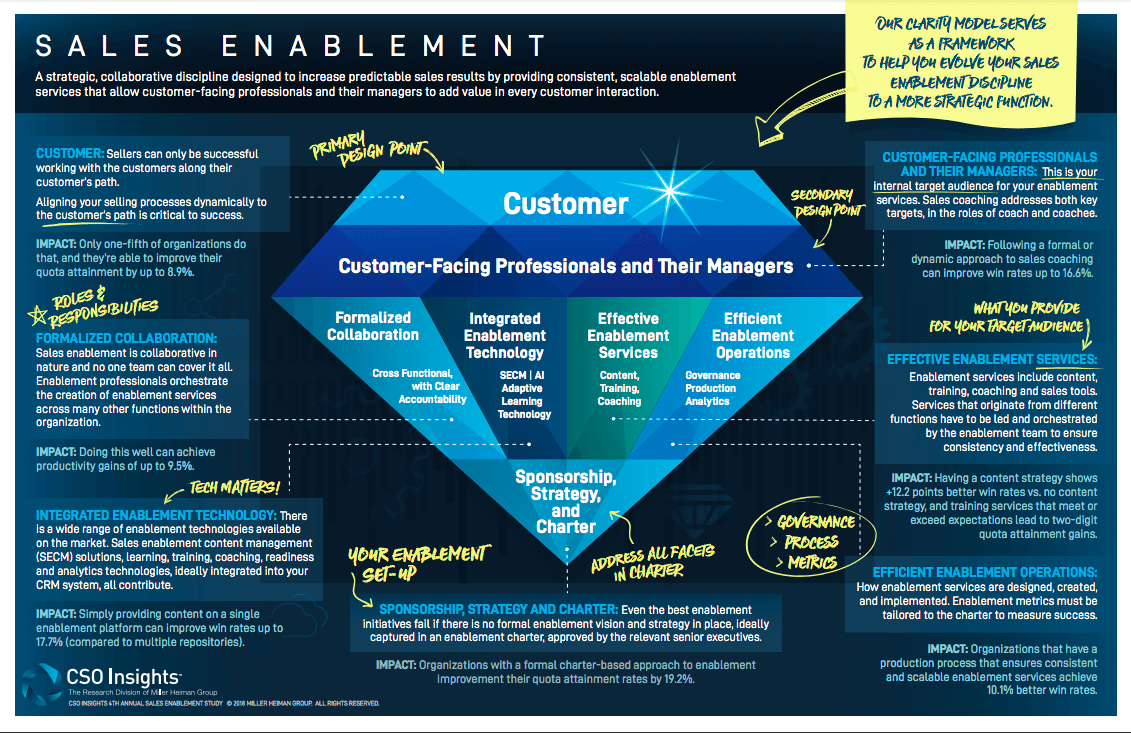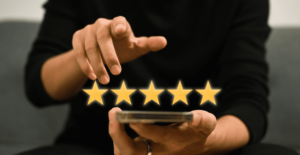Table of Contents
Play this out in your head.
Your sales rep is meeting with a prospect.
The prospect has already researched your offering, and other competitive offerings on the internet. They already have formed an opinion about their problem and the potential solutions.
What will it take for the sales rep to make an impression and eventually win the business?
The prospect should leave the discussion thinking “Ah! They are the right partner. They know what they are doing and if I choose them, they will help us solve the problem at hand.”
Is your sales rep equipped with the right information and knowledge to pull this off? Are you confident that they will be a trusted advisor for the prospect as they navigate the buying process?
If the answer is no, then you need to consider Sales Enablement.
Sales Enablement will help you establish processes and guidelines in your sales (and revenue) function that will arm your sales team with the right skills and content to help buyers navigate the buying process.
Traditionally, Sales Enablement was considered to be limited to business enterprises that had a large sales team and a complex product offering. However, with the advent of the web and easy access to information, smaller organizations with simple offerings cannot discount the importance of a properly enabled and equipped sales team.
It is a trendy buzzword for organizations worldwide with good reason, and here’s everything you need to know about it.
What Is Sales Enablement?
In today’s digital world, B2B buyers have access to unlimited information. Today’s buyers can research a problem, explore available solutions to those problems, and compare those solutions without ever speaking with anyone. Therefore, when these buyers pick up the phone or meet your sales team, they are not only well-rehearsed in what your solution does but also what other competitive solutions offer. However, this information overload has made the buying process complex for the B2B buyer.
According to a 2017 B2B Buying Survey by Gartner 77% of the buyers agree that the purchase process has become very complex and difficult.
To build trust and credibility with today’s buyers, your sales team should be equipped with information and content that will help them help the buyers navigate the buying process. Your sales reps need to serve as brokers of information that largely focus on finding and directing buyers to the right information, tools, and data.
A sales enablement program can help you arm your sales team with the right information to help buyers with the buying process.
SiriusDecisions (now acquired by Forrester) defines Sales Enablement as
“Sales enablement’s goal is to ensure that every seller has the required knowledge, skills, processes, and behaviors to optimize every interaction with buyers.”
HubSpot defines Sales Enablement as
“Sales enablement is the iterative process of providing your business’s sales team with the resources they need to close more deals. These resources may include content, tools, knowledge, and information to effectively sell your product or service to customers.”
Fundamentally, Sales Enablement is about equipping your sales and customer-facing teams with updated information, content, tools, and best practices to sell smarter and faster.
To outline sales enablement:
- Its primary objective is to equip salespeople with the resources to help close deals more effectively and efficiently.
- Although it systematizes the process for sales reps, sales enablement is more about the buyer’s needs. It is about equipping the sales team with resources that will help them help the buyers in the buying process. Therefore, sales enablement is buyer-centric.
- Sales Enablement resources include research, tools, and best practices that sales will consume and content that will help buyers with the buying process.
- Besides providing necessary resources, sales enablement also ensures that salespeople can use these resources. It’s why one of the defining parts of a sales enablement program is sales training and coaching.
- Lastly, Sales Enablement is about measuring your enablement with data and KPIs (Key Performance Indicators) that you need to track to improve sales success.
In even simpler terms, sales enablement is placing the right resource, content, and tools in salespeople’s hands at exactly the right time. It’s a competitive advantage to boost their sales performance.
Why Is Sales Enablement Important?
Sales enablement is starting to become the focus of many high-growing companies worldwide. So, why it should be an important goal for your business.
Putting the ideal sales enablement strategies tailored for your business needs in place can give several benefits to your company, including:
- Building out skill sets to deliver a remarkable buyer and customer experience
- Significant increase in your sales team’s productivity
- Shorten your sale cycle
- Reduce customer acquisition costs (CAC)
- Improve new rep onboarding and reduce time to close first deal
- Gain a better understanding and identification of training and tools needed by your sales reps
- Align your marketing and sales teams
- Obtain insights into your business’ sales performance data through reporting and analytics
An effective sales enablement program can positively impact every aspect of your company’s sales operations. Sales reps who have access to coaching modules and updated marketing tools and content are better prepared to close deals than those who lack the skills and training and access to relevant collateral.
Without a sales enablement program:
- Your sales team may be underperforming.
- Sales conversations may not convert.
- Sales deals will start slipping through cracks in your sales process.
Sales Enablement not only helps drive new logo sales, but it can also helps your company establish a sustainable process to increase your revenue over time. It doesn’t matter if you are offering the best and most cutting-edge products or services, if your sales team doesn’t have access to the right training and resources, it’s easy to lose customers and new sales opportunities.
To sum it up, putting up a sales enablement program can revamp your company’s overall sales outcome. It offers you an opportunity to drive sales readiness and performance.
What Are the Elements of a Sales Enablement Strategy?
Sales Enablement is a broad discipline. And this can confuse companies that are interested in establishing a sales enablement process. Therefore, it is important to understand the different elements of a sales enablement program. Understanding these elements will help you prioritize your sales enablement investments.
A Clear Plan
Every successful sales enablement program starts with a good plan. However, you can’t get a truly good plan without understanding your target persona or buyers, where your organization stands today, and your future goals.
Evaluating your sales team, especially the challenges and pain points that they face during the selling process, can be an important input to your sales enablement plan. Asking a couple of questions can help you dig deeper into the areas that need further support.
- What part of the sales process is slowing your team down?
- What sales questions are they often answering?
- Which buyer needs is the sales team unable to meet?
- What are market changes that affect your sales team’s performance?
- Can your salespeople strike strategic business conversations with the right people?
- What does your sales team need to expedite sales processes?
Answers to the above questions will help you prioritize your sales enablement investments.
Another important element of the plan, is to identify the Sales Enablement program stakeholders. Due to the nature of sales enablement discipline, it is common for non-sales stakeholders to actively drive sales enablement. For example, we believe that marketing is better suited to own sales content enablement
Sales Enablement Tools
It is possible to invest in sales enablement processes without bringing on additional tools. In fact, it is recommended that you establish manual processes first and use tools to improve those processes. Once you have identified a sales process that you want to improve, it will be easier to find a tool that will help you improve that process. Technology can clearly boost your sales enablement program to the next level.
There are many types of technology and tools that can support your sales organization, but they all exist for the same purpose. They can convert manual sales play into a smoother and more consistent process so your salespeople won’t be wasting their valuable time and effort in doing mundane tasks.
Sales Content Management
Today, your qualified buyers are looking for content that provides valuable information and insights. And they are looking to your salespeople to provide that information to them. After initial discovery, your sales reps know more about their buyer’s needs and challenges and are in the best position to connect them with the right information.
Creating great content may be something, but coming up with the right kind of content to serve a particular buyer is another. Even some great content can have unsettling statistics and go unused by your salespeople or the buyers.
The ideal solution to this dilemma would be to use sales content management technology or asset management tools. This tool can help you find, organize, and share the right sales collateral at the right time to the right buyer.
Sales Engagement Platforms
Administrative tasks like writing emails, researching, following up on prospects, entering data, are a huge productivity drain for your sales teams. Sales Engagement technologies can help streamline your sales team’s effort. These platforms also help you establish best practices on prospecting and research and scale those best practices across the sales team.
This type of sale enablement tool manages, measures, and optimizes your sales’ communication efforts. It helps your team save time and effort where they can so they can concentrate more on converting prospective buyers.
Account Planning Technology
One of the keys to a lucrative sales play is having a firm understanding of what drives and affects the buying process. Salespeople need to be updated and well-versed in industry trends, sales opportunities, the competition, and the changing buyer objectives.
However, not all sales reps have a strong grasp on these key details, making it challenging to match the right resource with the right sales opportunity.
This is where account planning solutions can help to structure the sales planning process. An account planning tool ensures that salespeople have a detailed and concise roadmap to build an account strategy and uncover sales opportunities. It also helps all the stakeholders to have visibility into the opportunities and potential risks that are associated with the account.
In the end, an account planning technology provides a seamless and more organized sales process that allows sales reps to identify high-potential accounts and revenue opportunities.
CRM
Customer Relationship Management tools are a must-have to manage and organize your client relationships and communication processes. However, CRM also does a couple more things you can leverage on, including tracking customer data and measuring sales results.
Besides being a system that keeps key records, you can also use CRM to track and measure your sales enablement initiatives’ success. For example, you can track your efforts’ conversion rates or the run-rate productivity if you want to minimize time-to-productivity for new hires.
Sales Management Tools
Sales reps should spend the majority of their time converting leads to sales and less on administrative works. While the CRM does well in collecting sales data and maintaining its accuracy, it doesn’t teach your salespeople how to use or apply the data collected on the sales process.
It’s where sales management tools come in. It ensures that your CRM’s raw data turn into actionable insights to boost your sales team’s performance. A sales management tool allows you to answer questions like:
- How likely is a particular deal to close?
- Does the sales team have enough deals working towards reaching the quarterly sales goal? How about the yearly sales number?
- What is the status of your key sales opportunities?
To sum it up, a sales management tool provides a central place for you to track and monitor your organization’s entire sales process.
Sales Playbook
A great sales enablement initiative should have an organized strategy. Hence, there should be a sales playbook that can guide your sales team through the complex sales process.
It’s a key piece to a successful sales enablement program, ensuring that your salespeople can access useful resources, day in and out.
Besides serving as a guide on various sales scenarios, a playbook can help streamline the entire sales process to keep your organization following best practices.
Think of a Sales Playbook as a recipe that brings together all the ingredients of a sales process. It is a prescriptive guide that helps sales reps navigate the buying process and win deals.
Sales Content and Optimization
Having access to the relevant content and resources can be a huge advantage for today’s modern sales reps. It helps them build trust and credibility, overcome objections, and ultimately close more deals.
This type of content can be email templates, data-sheets, proposal templates, eBooks, product demos, pricing and discount information, competitive guides, or case studies.
Creating sales content for every stage of the sales journey can expedite the entire process.
When Should Sales Enablement Be a Goal?
The purpose of sales enablement is simple and straightforward. It aims to help your sales team win more deals and boost revenue.
Here are some cases when a sales enablement program will give you the best advantages.
When the business is growing
Sales enablement strategies are not only for companies struggling to make significant revenue. Businesses in a high growth phase can also benefit from putting up this program.
When a business is booming, it’s easy to put the company’s long-term future on the back burner. This short-sightedness can cause dire problems down the road, and you might not be able to see a downgrading business performance until it’s too late.
Establishing a sales enablement strategy while your business is going up ensures that your organization will consistently result in high growth.
When hiring new sales representatives
A sales organization is a revenue center. The primary goal of sales leadership is to generate more sales. Therefore, when companies onboard new sales reps, they want them to start generating revenue from day one.
However, it takes time for the newly onboarded reps to understand the offering, the messaging, and the buyers to be effective in the selling process and generate revenue.
A well defined and executed sales enablement program can reduce the onboarding time significantly. It can provide the necessary content and resources for a newly joined rep to become productive and effective in the selling process and ultimately win their first deal.
Having sales readiness programs will help every team member, both old and new, achieve peak performance. The strategy will help improve their effectiveness and efficiency so they can meet their sales quotas faster.
When sales reps become unproductive
When sales reps spend the majority of their time on non-selling tasks, it’s also money burned for your business. Sales enablement programs will help their productivity, reducing or even eliminating the time they spend doing admin tasks. Instead, they can focus on converting leads and closing deals.
You have to reduce tasks that aren’t productive to increase the organization’s sales productivity, and that’s where sales enablement helps immensely.
When raising sales quotas
If you plan to increase your sales quotas for the next quarter or next year, you can benefit from establishing a good sales enablement program.
Using new strategies and sales tools can boost your team’s productivity and performance. Providing them with an updated training and coaching program as part of your sales enablement initiative will put them in a more superior position to drive more sales.
A new set of skills from a well-trained salesperson will also amount to achieving higher quotas.
When marketing efforts don’t translate into sales
You increase your marketing efforts in hopes of boosting your sales. When your marketing initiative flops, it’s another pile of money burned.
If you want to ensure that your marketing budget increase translates into more sales for your team, sales enablement programs can help. When marketing and sales efforts are aligned and work closely together, the organization will have a much better outcome.
Establishing a sales enablement strategy helps bridge the gap between your sales team’s needs and your marketing efforts.
In each of these cases, you can sustain your sales success and even boost it further by employing sales enablement strategies.
What Sales Enablement Can Do For You
Ultimately, there are many things a good sales enablement program can do for your organization.
- Enhance and accelerate time-to-productivity
- Coach sales reps in skill areas that they need to improve
- Track and streamline business outcomes
- Establish guided role-play in all sales processes
- Build your team’s skills through development activities and tailored learning to improve efficiency and effectiveness
Sales enablement gives your organization a sustainable process to increase sales for years to come. If you plan to build up your sales team and efforts, sales enablement can help.
How Do You Measure Sales Enablement?
Sales enablement doesn’t end with providing the sales team with useful resources and establishing a guided role-play for a seamless sales process. The success of the program also includes tracking and monitoring performance.
Sales Enablement Metrics and KPIs You Should Be Measuring
Before you can identify if your sales enablement program is successful or not, it’s important to ensure that your sales force has everything it needs to track and monitor results. In this case, it’s necessary to determine what metrics or KPIs matter most to help you accomplish your sales goals.
Here are several metrics and KPIs that your sales enablement efforts can influence, both directly and indirectly.
Closing Rate (Time Spent Selling)
The ultimate goal of employing a sales enablement strategy is to expedite the sales process. It should allow the sales reps to close deals easier and faster. It’s why the time spent by reps to close deals is a good indicator of how effective your program is.
Conversion Rate (Lead-to-Opportunity Conversion Rate)
Your strategy aims to equip sales reps with the right tools to engage buyers. Hence, the conversion rate matters in determining if your sales enablement is effective.
Time-to-Quota
This metric combines other significant metrics like the closing rate and lead-to-opportunity conversion rate. After all, a sales enablement program gives reps effective knowledge and resources to improve their efficiency, allowing them to reach their quotas easier and faster.
Leading Indicators
If you’ve been keeping a close eye on your metrics and KPIs, you’ve probably identified leading indicators that can predict the highest sale opportunity. Leading indicators help you predict future sales performance and identify which areas need improvement.
Having a pulse of these metrics will help you gauge the success of your strategy.
When deciding how to empower your sales team, establishing a well-thought sales enablement program is a great option. It’s one of the best and long-term solutions to equip sales with the right resource and tools to drive sales and boost revenue for years to come.
However, it’s imperative to understand that there is no one-size-fits-all approach in developing a sales enablement program. Hence, it’s important to develop your strategy based on your business realities and goals to benefit from sales enablement.







